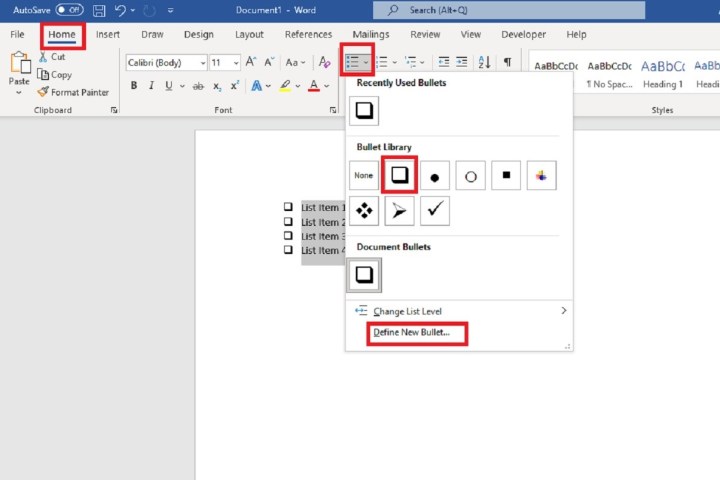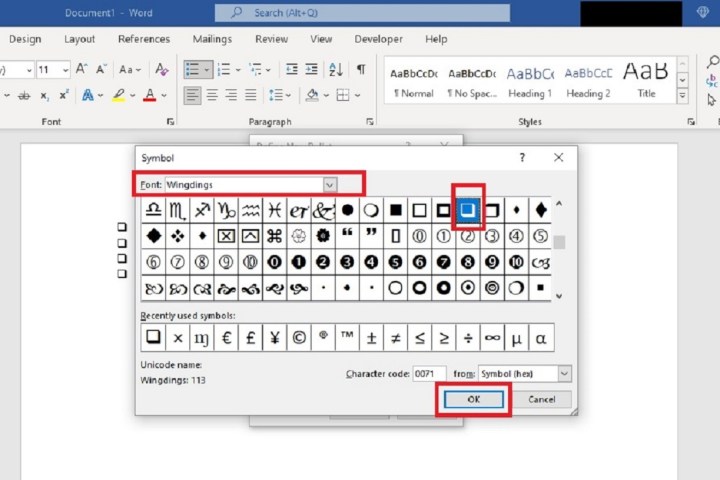Whether you’re outlining a recipe or putting together a daily to-do list, Microsoft Word is a great tool for keeping all your ideas and information organized. Beyond its word processing capabilities, you’ll even be able to create electronic checkboxes that you can tick and untick. It’s really easy to do, and we put together this step-by-step guide to teach you how.
Display the Developer tab to enable the checkbox feature (for Windows)
Before you can even add a checkbox to your list, you have to enable the checkbox feature (and the tab menu it's housed within). In this case, the checkbox feature is located within the Developer tab, which is a menu that isn't shown by default. You have to enable that menu first. Here's how:
Step 1: Select the File tab in the top-left corner and then choose Options in the bottom-left corner of the next screen. (You may need to select More before you can see Options).
Step 2: Select Customize ribbon.
Step 3: On the Word options screen, there are two columns. Look at the column on the right. Under that column's drop-down menu, the one labeled Main tabs, look for the word Developer and tick the box next to it. Then select OK.

Step 4: The Developer tab should now appear at the top of your screen in the main ribbon menu. You can select it to view its options and tools.
Display the Developer tab to enable the checkbox feature (for macOS)
If you are working on Word in macOS, you will also need to start by enabling the Developer tab. However, the settings work a little differently. Here's what you need to do:
Step 1: Open your Word doc. Look at the very top of the document window, where you will see icons for saving, printing, undoing, and going to the Word home page. Select the Small menu arrow on the right.

Step 2: Select More commands from the drop-down menu.

Step 3: You should now be in the Ribbon & toolbar menu. Select Ribbon to reveal more options.
Step 4: On the right side of the menu, you'll see the option to Customize the ribbon. Scroll down here until you reach Developer at the bottom, and select it to enable this tab.
Select Save. Exit out of the menu and you will now see the Developer tab in your Word document.
How to insert a checkbox in Word (for Windows)
Step 1: Write up your list, then place your cursor at the beginning of the first line of your list. Be sure to leave a space between the first word of your first line and where you want to add the checkbox.
Step 2: Select the Developer tab from the ribbon menu.
Step 3: Within the Developer tab, look at the section labeled Controls. In that section, look for a Box icon with a check mark inside of it. Select this icon. You've just inserted your first checkbox.

Step 4: For rest of the lines in your checklist, select the first checkbox you created and the space after it, and then copy and paste that selection to the beginning of each of the rest of your lines.
Step 5: Once you're ready to electronically check a list item on your new checklist, simply select the Checkbox to add an X to the box.
How to insert a checkbox in Word (for macOS)
With the Developer tab enabled in your macOS version of Word, creating checkboxes is very easy. Here's what you need to do:
Step 1: Type up your checklist, then place your cursor at the start of the first item on your checklist.
Step 2: Navigate to the Developer tab in your Ribbon menu. Here, look for an option called Check Box, with the icon of a checked box. Select it.

Step 3: You have now added a checkbox to the first item on your list! Repeat the action at the beginning of each item to add a checkbox to them all.

Step 4: In the macOS version of Word, checking the boxes works a little differently -- you can't just select them to check them off. Instead, double-click on the Checkbox to open the Options menu.
Under Default value, select Checked. Then select OK. Your checkbox will now be checked.
How to create a print-only checklist (one that can't be checked electronically)
If you want checkboxes for your list, but don't need them to be clickable (checked electronically), you can just create a bulleted list with checkbox-shaped bullets.
Note: This option isn't necessary for macOS, because the checkboxes on the Mac version of Word are automatically print-only, unless you go into the Options menu, as described above.
Step 1: Type up your list. Then select the whole list.
Step 2: Select the Home tab on the ribbon, if it's not already selected.
Step 3: Select the Down arrow icon next to the Bullets icon.

Step 4: Choose a Box-shaped symbol from the menu that appears. If you don't see one, choose Define new bullet from the menu instead.
Step 5: If you end up choosing Define new bullet, select Symbol on the dialogue box that pops up.

Step 6: Choose a font from the drop-down menu labeled Font. Wingdings is a good font for checkboxes. Choose your preferred checkbox symbol and then select OK twice. You now have a print-only checklist.

What about adding Word checklists in ChromeOS?
If you are working on a Chromebook, we typically suggest using the online version of Word, a free web app that runs well on ChromeOS and uses OneDrive as cloud storage, which is an ideal solution in many situations.
However, creating checklists poses a problem. The online version of Word does not have the option to enable a Developer tab, and there is no way to create checklists. There is an Android version of Word you can find on Google Play, but it doesn't support Developer options either -- and Microsoft dropped Chromebook support for its Android Word app in late 2021.
So, where does that leave Chromebook users? If you want to print off a checklist, you can still sort of create one in the online Word app. Users can go to Insert > Drawing > Shapes and select a Square. Create a small square at the front of your checklist item (choose whatever color you want), then copy and paste it at the front of each item, as shown above. It's a rough workaround but will get you a printable checklist.
What is the Developer tab?
Both the Windows and macOS desktop versions of Word have Developer tabs built into the UI. One can think of the Developer tab as a settings and customizations dashboard. Even though you’ll have plenty of settings to choose from without the Developer tab being visible, unlocking it gives users access to more advanced capabilities.
These include functions like creating macros for document automations, creating re-usable doc templates, and XML mapping.
Do all versions of Word have a Developer tab?
While the Developer tab has been a core part of Microsoft Word for a long time, the feature has been hidden away in the software since Word 2007. Since then, it hasn’t been visible on Word 2010, Word 2013, Word 2016, Word 2019, or Word 365.



